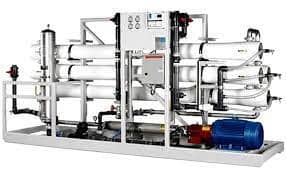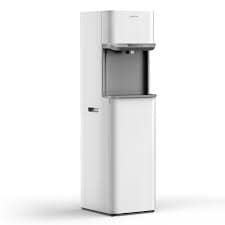Description
RO System
If you’re looking for a reliable and effective water filtration system, a Reverse Osmosis (RO) system is the way to go. RO systems use a multi-stage process to remove impurities from water and provide safe and clean drinking water. In this article, we’ll discuss everything you need to know about RO systems, including how they work, the benefits they offer, and how to choose the best one for your needs.
What is an RO system?
An RO system is a water filtration system that uses a multi-stage process to remove impurities from water. The process includes a pre-filter to remove sediments, a carbon filter to remove chlorine and other chemicals, and a semi-permeable membrane that removes dissolved solids, such as salts and minerals. RO systems are designed to provide clean, safe, and healthy drinking water.
How does an RO system work?
RO systems use a semi-permeable membrane to filter water. The membrane has tiny pores that allow water molecules to pass through while blocking larger molecules, such as dissolved solids, bacteria, and viruses. The process involves several stages:
Stage 1: Pre-filter
The pre-filter is designed to remove sediments such as sand, dirt, and rust from the water. It helps to protect the RO membrane and prolong its lifespan.
Stage 2: Carbon filter
The carbon filter is designed to remove chlorine, pesticides, and other chemicals from the water. It helps to improve the taste and odor of the water.
Stage 3: RO membrane
The RO membrane is the heart of the system. It removes dissolved solids, such as salts and minerals, from the water. It also removes bacteria, viruses, and other contaminants from the water.
Stage 4: Post-filter
The post-filter is designed to remove any remaining impurities from the water. It helps to improve the taste and quality of the water.
What are the benefits of an RO system?
An RO system offers several benefits, including:
- Removes impurities: RO systems remove impurities such as sediments, chlorine, pesticides, and dissolved solids from water, providing safe and clean drinking water.
- Improves taste: RO systems remove the taste and odor of water caused by chlorine and other chemicals, providing better-tasting water.
- Saves money: An RO system can help you save money by providing clean drinking water at home instead of buying bottled water.
- Easy to maintain: RO systems are easy to maintain and require minimal upkeep.
How to choose the best RO system?
Choosing the best RO system can be overwhelming with so many options available. Here are some factors to consider when choosing an RO system:
1. Water quality
The quality of your water will determine the type of RO system you need. If your water has high levels of dissolved solids, you will need an RO system with a high rejection rate to remove the impurities effectively.
2. Flow rate
The flow rate of an RO system determines how much water it can filter per day. Choose an RO system with a higher flow rate if you have a large family or use a lot of water.
3. Storage capacity
The storage capacity of an RO system determines how much filtered water it can store. Choose an RO system with a higher storage capacity if you have a large family or need a lot of water.
4. Ease of installation
Choose an RO system that is easy to install and requires minimal plumbing work. Some systems require professional installation, while others can be installed by the homeowner.
5. Price
RO systems vary in price, depending on their features and quality. Set a budget and choose an RO system that meets your needs and fits your budget
Types of RO systems
There are different types of RO systems available in the market, including:
1. Under-sink RO systems
Under-sink RO systems are installed under the kitchen sink and are connected to a separate faucet. These systems are compact and are ideal for homes with limited space.
2. Countertop RO systems
Countertop RO systems are installed on the kitchen countertop and are connected to the main faucet. These systems are portable and can be moved from one location to another.
3. Portable RO systems
Portable RO systems are compact and lightweight, making them ideal for camping and outdoor activities. These systems can be easily transported and do not require electricity.
4. Whole-house RO systems
Whole-house RO systems are designed to filter water for the entire house. These systems are usually installed in the basement or garage and require professional installation.
Maintenance of RO systems
RO systems require regular maintenance to ensure optimal performance. Here are some tips to maintain your RO system:
1. Replace filters
RO systems have different filters that need to be replaced regularly. The pre-filter and carbon filter need to be replaced every 6-12 months, while the RO membrane and post-filter need to be replaced every 2-3 years.
2. Clean the system
Clean the system regularly to remove any dirt and debris that may accumulate in the system. Use a soft cloth and warm water to clean the system.
3. Check for leaks
Check the system regularly for any leaks or damages. If you notice any leaks or damages, contact a professional to repair the system.
4. Test water quality
Test the water quality regularly to ensure that the system is working properly. You can use a water testing kit to test the water quality.
Conclusion
An RO system is an effective and reliable way to provide clean, safe, and healthy drinking water. When choosing an RO system, consider the water quality, flow rate, storage capacity, ease of installation, and price. Regular maintenance is essential to ensure optimal performance and prolong the lifespan of the system.
FAQs
- Can an RO system remove bacteria and viruses from water?
Yes, an RO system can remove bacteria and viruses from water.
- How long does an RO system last?
An RO system can last up to 10 years with proper maintenance.
- How often do I need to replace the filters in my RO system?
The pre-filter and carbon filter need to be replaced every 6-12 months, while the RO membrane and post-filter need to be replaced every 2-3 years.
- How much does an RO system cost?
The cost of an RO system varies depending on its features and quality. A basic system can cost around $100, while a high-end system can cost up to $1000.
- Can I install an RO system myself?
Some RO systems can be installed by the homeowner, while others require professional installation. Check the installation instructions before purchasing the system.








Aqua Filter –
Aquaafilter is the perfect choice for anyone in need of water filter services. Their team is knowledgeable, friendly, and always willing to provide personalized solutions.